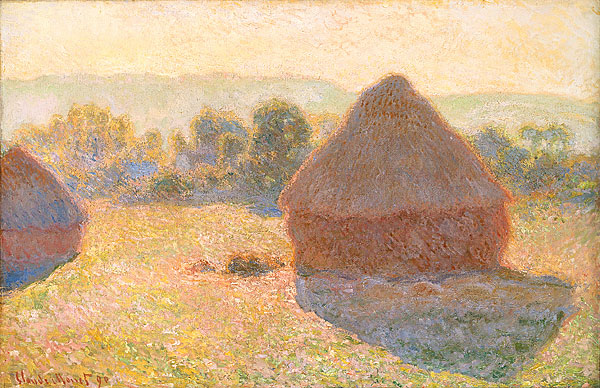
“Meules, milieu du jour” by Claude Monet is the original French title, which means “Stacks Middle of the Day” and is part of a series of piles of harvested wheat.
The series consists of twenty-five canvas, which Monet began near the end of the summer of 1890, and though Monet also produced earlier paintings using this same stack subject.
The impressionist series is famous for how Monet repeated the same theme to show the different light and atmosphere at different times of day, across the seasons, and in many types of weather.
Monet’s Haystacks series is one of his earliest to rely on repetition of a subject to illustrate a subtle difference in color perception across variations of times of day, seasons, and weather.
The stacks belonged to Monet’s neighbor, and Monet noticed from his farm the way the light changed on the stacks. Monet started with two canvases, a sunny and an overcast version.
But Monet soon found he could not catch the ever-changing light and mood on just two paintings.
Although he began painting the stacks en Plein air, Monet later revised his first impressions in his studio, both to generate contrast and to keep the harmony within the series.
The Haystacks series was a financial success for Monet. Every painting sold within days when the Haystack series was first exhibited in 1891.
The show met with great public acclaim, and as most of the pictures sold quickly, Monet’s prices began to rise steeply.
As a result, he was able to buy outright for his house and grounds at Giverny and to start constructing a waterlily pond. After years of mere subsistence living, he was able to enjoy financial success
Claude Monet
Oscar-Claude Monet was a founder of French Impressionist painting, and the term “Impressionism” is derived from the title of his painting Impression, “Soleil Levant” or “Impression, Sunrise,” which was exhibited in 1874.
Monet adopted a method of painting in which he painted the same scene many times to capture the changing of light and the passing of the seasons.
Monet is known for having produced a series of paintings, all versions of the same subject and perspective. Examples include his series of the “Valley of the Creuse” series and his famous series of “Haystacks” and “Water Lilies” paintings.
From 1883 Monet lived in Giverny, where at his home, he developed a garden landscape that included the lily ponds that would become the subjects of his best-known works.
In 1899 he began painting the water lilies, first with a Japanese bridge as a central feature, and later in the series of large-scale paintings, with the water lilies as the main feature. This series occupied him for the last 20 years of his life.
Meules, milieu du jour
- Title: Meules, milieu du jour
- Artist: Claude Monet
- Year: 1890-91
- Medium: Oil on canvas
- Dimensions: Height: 65.6 cm (25.8 ″); Width: 100.6 cm (39.6 ″)
- Museum: National Gallery of Australia
Les meules de Monet
Claude Monet
- Name: Oscar-Claude Monet
- Born: 1840 – Paris, France
- Died: 1926 (aged 86) – Giverny, France
- Nationality: French
- Movement: Impressionism
- Notable works:
- Reflections of Clouds on the Water-Lily Pond
- Farmyard in Normandy
- The Basin at Argenteuil
- A Cart on the Snowy Road at Honfleur
- Water Lilies, (National Museum of Western Art, Tokyo)
- Camille Monet on a Bench
- The Houses of Parliament (Effect of Fog) – (MET)
- “Houses of Parliament, London” (Art Institute of Chicago)
- “The Houses of Parliament, Sunset” (National Gallery of Art, DC)
- “London, Houses of Parliament. The Sun Shining through the Fog” (Musée d’Orsay)
- “Seagulls, the River Thames and the Houses of Parliament” (Pushkin Museum)
- Haystacks at Scottish National Gallery
- Stacks of Wheat (End of Day, Autumn) at Art Institute of Chicago
- Stacks of Wheat (End of Summer) at Art Institute of Chicago
- “Meules, milieu du jour” (National Gallery of Australia)
- “Wheatstacks, Snow Effect, Morning” (Getty Museum)
- Garden at Sainte-Adresse
- Poppy Field in a Hollow near Giverny
- The Gare St-Lazare (The National Gallery, London)
- “La Gare Saint-Lazare” by Claude Monet (Musée d’Orsay)
- “Arrival of the Normandy Train, Gare Saint-Lazare” by Claude Monet (Art Institute of Chicago)
Monet’s Radiant Icon of Impressionism
A Tour of the National Gallery of Australia
- “The Green Parasol” by E. Phillips Fox
- “Landscape, Antibes (The Bay of Nice)” by John Peter Russell
- “Bridge and Wattle at Warrandyte” by Penleigh Boyd
- “Child in The Bush” by Frederick McCubbin
- “Miss Minna Simpson” by Tom Roberts
- “From McMahon’s Point – fare one penny” by Arthur Streeton
- “The Spirit of the Drought” by Arthur Streeton
- “Hot Wind” by Charles Conder
- “Purrumbete from across the Lake” by Eugene von Guerard
- Convict artist Richard Browne’s Watercolors
- “Govett’s Leap” by Eugene von Guerard
- “Pastorale” by Rupert Bunny
- “Meules, milieu du jour” by Claude Monet
Claude Monet’s Grainstack Paintings
~~~
“Colors pursue me like a constant worry. They even worry me in my sleep.”
– Claude Monet
~~~
Photo Credit: 1) Claude Monet [Public domain]
Popular this Week








 Sponsor your Favorite Page
Sponsor your Favorite Page SEARCH Search for: Search Follow UsJoin – The JOM Membership Program
Sponsor a Masterpiece with YOUR NAME CHOICE for $5
Share this:
- Tweet
